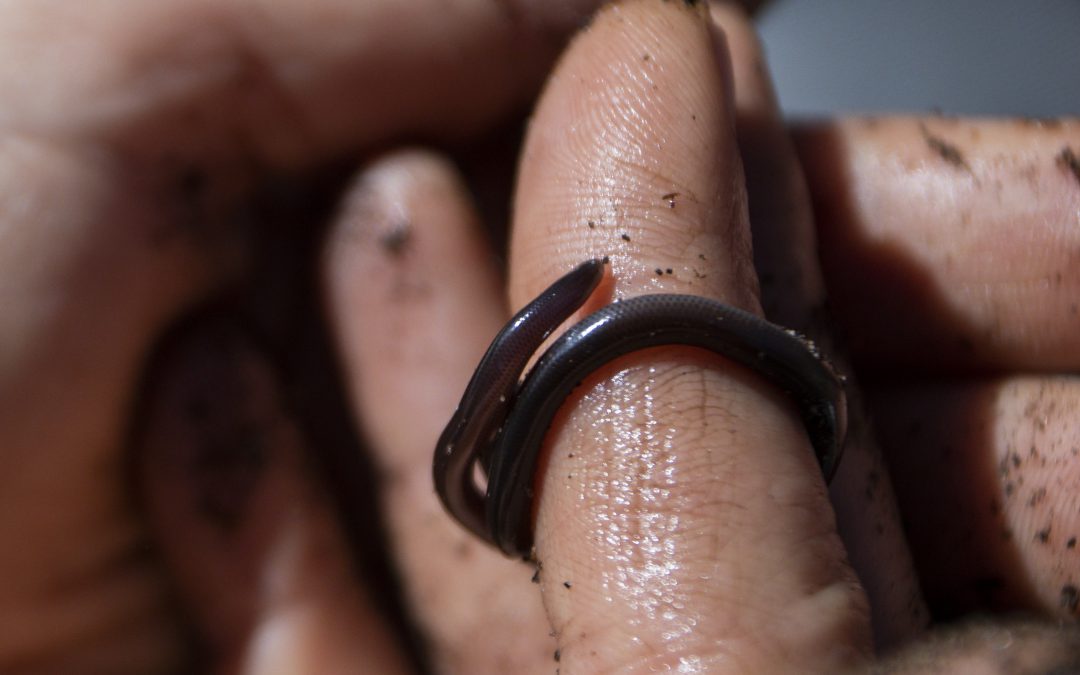
by Scott Jackson | May 26, 2022
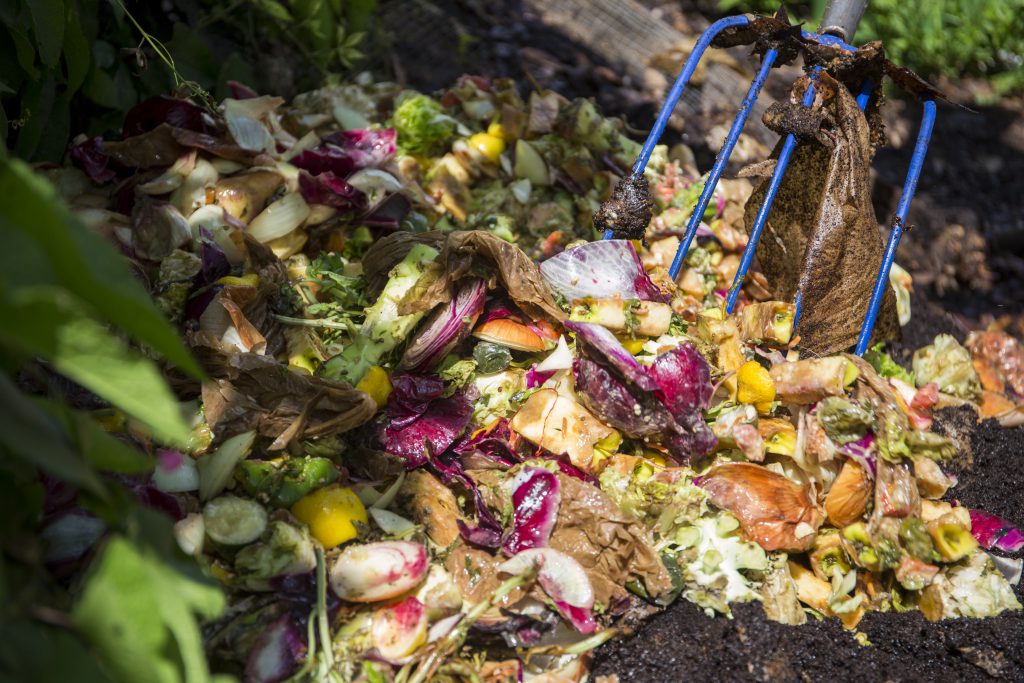
Nutrients found in food waste are too valuable to just toss away. Small scale composting and vermicomposting provide opportunity to recycle food waste even in limited spaces. UF/IFAS Photo by Camila Guillen.
During the summer season, my house is filled with family and friends visiting on vacation or just hanging out on the weekends. The kitchen is a popular place while waiting on the next outdoor adventure. I enjoy working together to cook meals, bbq, or just make a few snacks. Despite the increased numbers of visitors during this time, some food is leftover and ultimately tossed away as waste. Food waste occurs every day in our homes, restaurants, and grocery stores and not just this time of year.
The United States Food and Drug Administration estimates that 30 to 40 percent of our food supply is wasted each year. The United States Department of Agriculture cites food waste as the largest type of solid waste at our landfills. This is a complex problem representing many issues that require our attention to be corrected. Moving food to those in need is the largest challenge being addressed by multiple agencies, companies, and local community action groups. Learn more about the Food Waste Alliance at https://foodwastealliance.org
According to the program website, the Food Waste Alliance has three major goals to help address food waste:
Goal #1 REDUCE THE AMOUNT OF FOOD WASTE GENERATED. An estimated 25-40% of food grown, processed, and transported in the U.S. will never be consumed.
Goal #2 DONATE MORE SAFE, NUTRITIOUS FOOD TO PEOPLE IN NEED. Some generated food waste is safe to eat and can be donated to food banks and anti-hunger organizations, providing nutrition to those in need.
Goal #3 RECYCLE UNAVOIDABLE FOOD WASTE, DIVERTING IT FROM LANDFILLS. For food waste, a landfill is the end of the line; but when composted, it can be recycled into soil or energy.
All these priorities are equally important and necessary to completely address our country’s food waste issues. However, goal three is where I would like to give some tips and insight. Composting food waste holds the promise of supplying recycled nutrients that can be used to grow new crops of food or for enhancing growth of ornamental plants. Composting occurs at different scales ranging from a few pounds to tons. All types of composting whether big or small are meaningful in addressing food waste issues and providing value to homeowners and farmers. A specialized type of composting known as vermicomposting uses red wiggler worms to accelerate the breakdown of vegetable and fruit waste into valuable soil amendments and liquid fertilizer. These products can be safely used in home gardens and landscapes, and on house plants.
Composting meat or animal waste is not recommended for home composting operations as it can potentially introduce sources of food borne illness into the fertilizer and the plants where it is used. Vegetable and Fruit wastes are perfect for composting and do not have these problems.
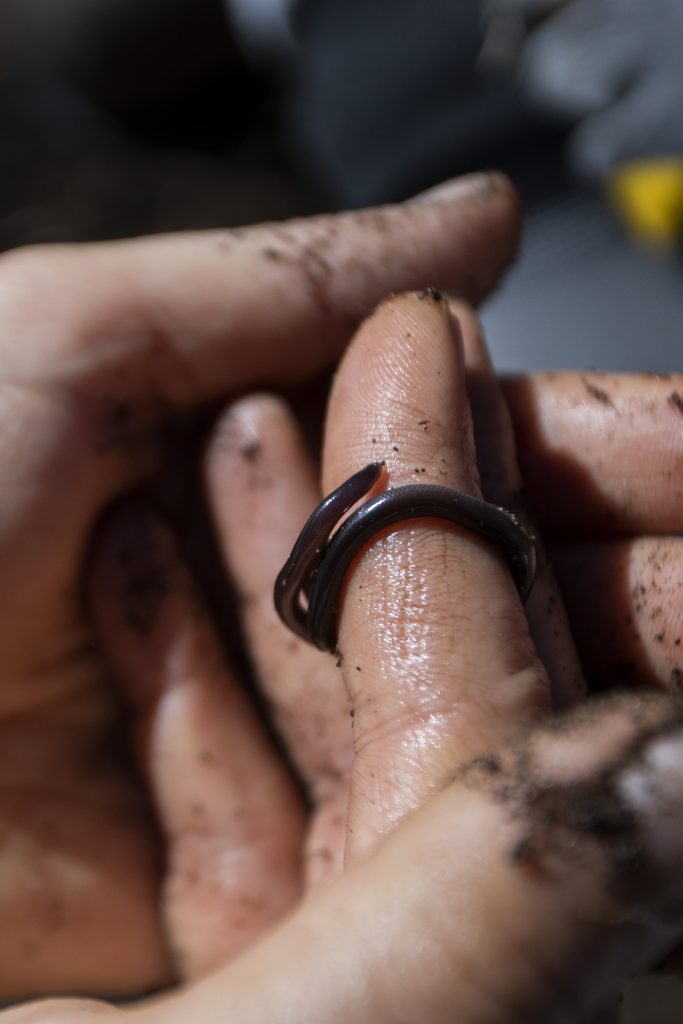
Composting worms help turn food waste into valuable fertilizer. UF/IFAS Photo by Tyler Jones
Detailed articles on how vermicomposting works are provided by Tia Silvasy, UF/IFAS Extension Orange County at https://blogs.ifas.ufl.edu/orangeco/2020/12/10/vermicomposting-using-worms-for-composting and https://sfyl.ifas.ufl.edu/media/sfylifasufledu/orange/hort-res/docs/pdf/021-Vermicomposting—Cheap-and-Easy-Worm-Bin.pdf Supplies are readily available and relatively inexpensive. Please see the above links for details.
A small vermicomposting system would include:
• Red Wiggler worms (local vendors or internet)
• Two Plastic Storage Bins (approximately 30” L x 20” W x 17” H) with pieces of brick or stone
• Shredded Paper (newspaper or other suitable material)
• Vegetable and Fruit Scraps
Red Wiggler worms specialize in breaking down food scraps unlike earthworms which process organic matter in soil. Getting the correct worms for vermicomposting is an important step. Red Wigglers can consume as much as their weight in one day! Beginning with a small scale of 1 to 2 pounds of worms is a great way to start. Sources and suppliers can be readily located on the internet.
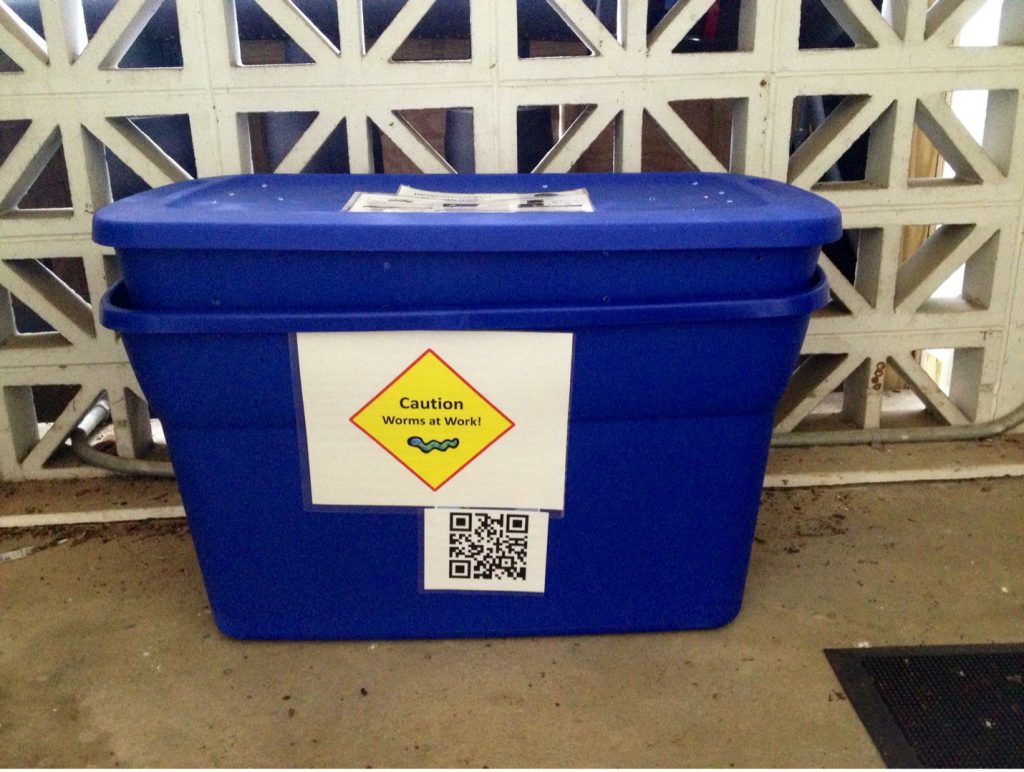
Worm “homes” can be constructed from two plastic storage bins with air holes drilled on the top. Additional holes put in the bottom of the inner bin to drain liquid nutrients. Pieces of stone or brick can be used to raise the inner bin slightly. Picture provided by UF/IFAS Extension Leon County, Molly Jameson
Once the worms and shredded paper media have been introduced into the bins, you are ready to process kitchen scraps and other plant-based leftovers. Food waste can be placed in the worm bins by moving along the bin in sections. Simply rotate the area where the next group of scraps are placed. See example diagram. For additional information or questions please contact our office at 850-784-6105.

Placing food scraps in a sequential order allows worms to find their new food easily. Contributed diagram by L. Scott Jackson
Portions of this article originally published in the Panama City News Herald
UF/IFAS is An Equal Opportunity Institution.
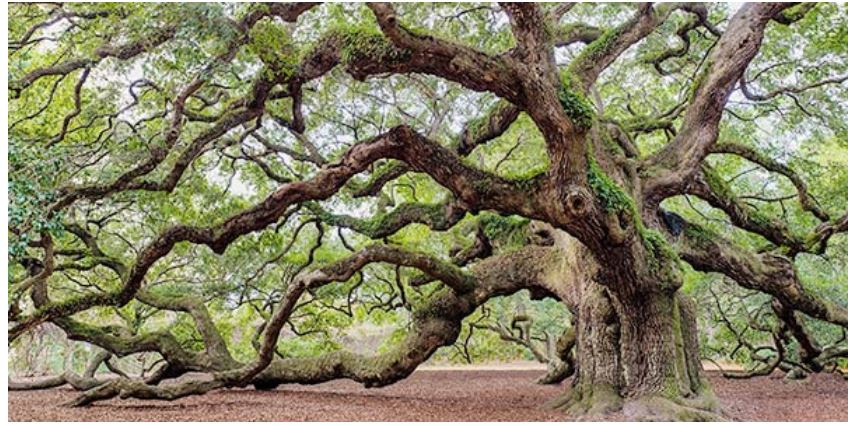
by Sheila Dunning | Jan 6, 2022
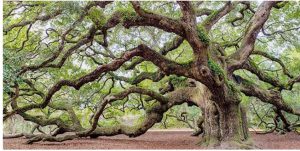
Old Live Oak
Picture from National Wildlife Foundation
The best time to plant a tree is twenty years ago. The second best time is Arbor Day. Florida recognizes the event on the third Friday in January, but planting any time before spring will establish a tree quickly.
Arbor Day is an annual observance that celebrates the role of trees in our lives and promotes tree planting and care. As a formal holiday, it was first observed on April 10, 1872 in the state of Nebraska. Today, every state and many countries join in the recognition of trees impact on people and the environment.
Trees are the longest living organisms on the planet and one of the earth’s greatest natural resources. They keep our air supply clean, reduce noise pollution, improve water quality, help prevent erosion, provide food and building materials, create shade, and help make our landscapes look beautiful. A single tree produces approximately 260 pounds of oxygen per year. That means two mature trees can supply enough oxygen annually to support a family of four.
The idea for Arbor Day in the U.S. began with Julius Sterling Morton. In 1854 he moved from Detroit to the area that is now the state of Nebraska. J. Sterling Morton was a journalist and nature lover who noticed that there were virtually no trees in Nebraska. He wrote and spoke about environmental stewardship and encouraged everyone to plant trees. Morton emphasized that trees were needed to act as windbreaks, to stabilize the soil, to provide shade, as well as fuel and building materials for the early pioneers to prosper in the developing state.
In 1872, The State Board of Agriculture accepted a resolution by J. Sterling Morton “to set aside one day to plant trees, both forest and fruit.” On April 10, 1872 one million trees were planted in Nebraska in honor of the first Arbor Day. Shortly after the 1872 observance, several other states passed legislation to observe Arbor Day. By 1920, 45 states and territories celebrated Arbor Day. Richard Nixon proclaimed the last Friday in April as National Arbor Day during his presidency in 1970.
Today, all 50 states in the U.S. have official Arbor Day, usually at a time of year that has the correct climatological conditions for planting trees. For Florida, the ideal tree planting time is January, so Florida’s Arbor Day is celebrated on the third Friday of the month. Similar events are observed throughout the world. In Israel it is the Tu B Shevat (New Year for Trees). Germany has Tag des Baumes. Japan and Korea celebrate an entire week in April. Even Iceland, one of the most treeless countries in the world observes Student’s Afforestation Day.
The trees planted on Arbor Day show a concern for future generations. The simple act of planting a tree represents a belief that the tree will grow and someday provide wood products, wildlife habitat, erosion control, shelter from wind and sun, beauty, and inspiration for ourselves and our children.
“It is well that you should celebrate your Arbor Day thoughtfully, for within your lifetime the nation’s need of trees will become serious. We of an older generation can get along with what we have, though with growing hardship; but in your full manhood and womanhood you will want what nature once so bountifully supplied and man so thoughtlessly destroyed; and because of that want you will reproach us, not for what we have used, but for what we have wasted.”
~Theodore Roosevelt, 1907 Arbor Day Message
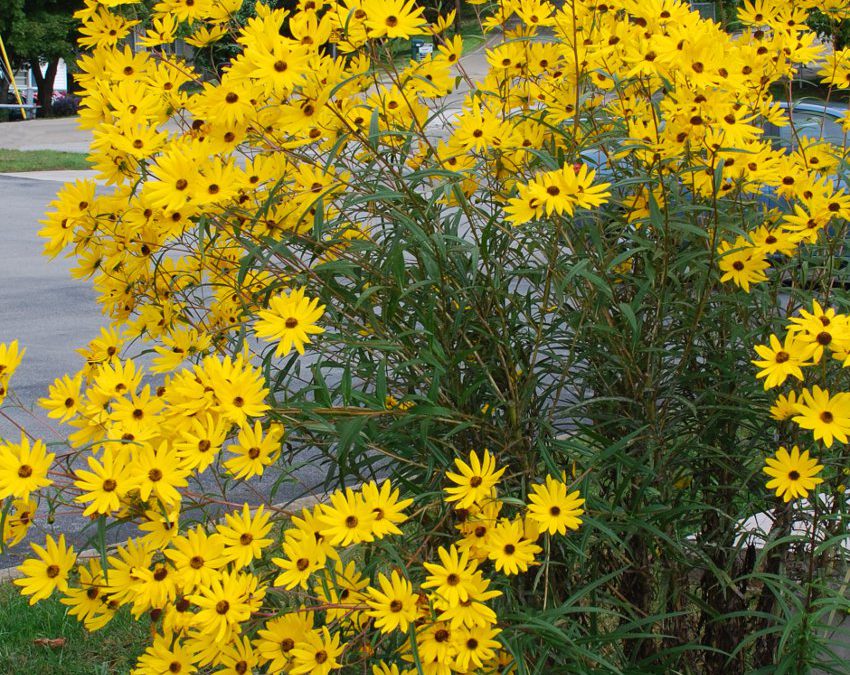
by Sheila Dunning | Oct 7, 2021
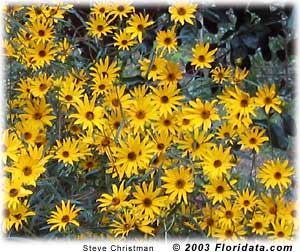
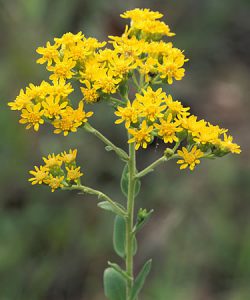
Goldenrod
Each fall, nature puts on a brilliant show of color throughout the United States. As the temperatures drop, autumn encourages the “leaf peepers” to hit the road in search of the red-, yellow- and orange-colored leaves of the northern deciduous trees. Here in the Florida Panhandle, fall color means wildflowers. As one drives the roads it’s nearly impossible to not see the bright yellows in the ditches and along the wood’s edge. Golden Asters (Chrysopsis spp.), Tickseeds (Coreopsis spp.), Silkgrasses (Pityopsis spp.), Sunflowers (Helianthus spp.) and Goldenrods (Solidago spp.) are displaying their petals of gold at every turn. These wildflowers are all members of the Aster family, one of the largest plant families in the world. For most, envisioning an Aster means a flower that looks like a daisy. While many are daisy-like in structure, others lack the petals and appear more like cascading sprays. So, if you are one of the many “hitting the road in search of fall color”, head to open areas. For wildflowers, that means rural locations with limited homes and businesses. Forested areas and non-grazed pastures typically have showy displays, especially when a spring burn was performed earlier in the year. With the drought we experienced, moist, low-lying areas will naturally be the best areas to view the many golden wildflowers. Visit the Florida Wildflower Foundation website, www.flawildflowers.org/bloom.php, to see both what’s in bloom and the locations of the state’s prime viewing areas.
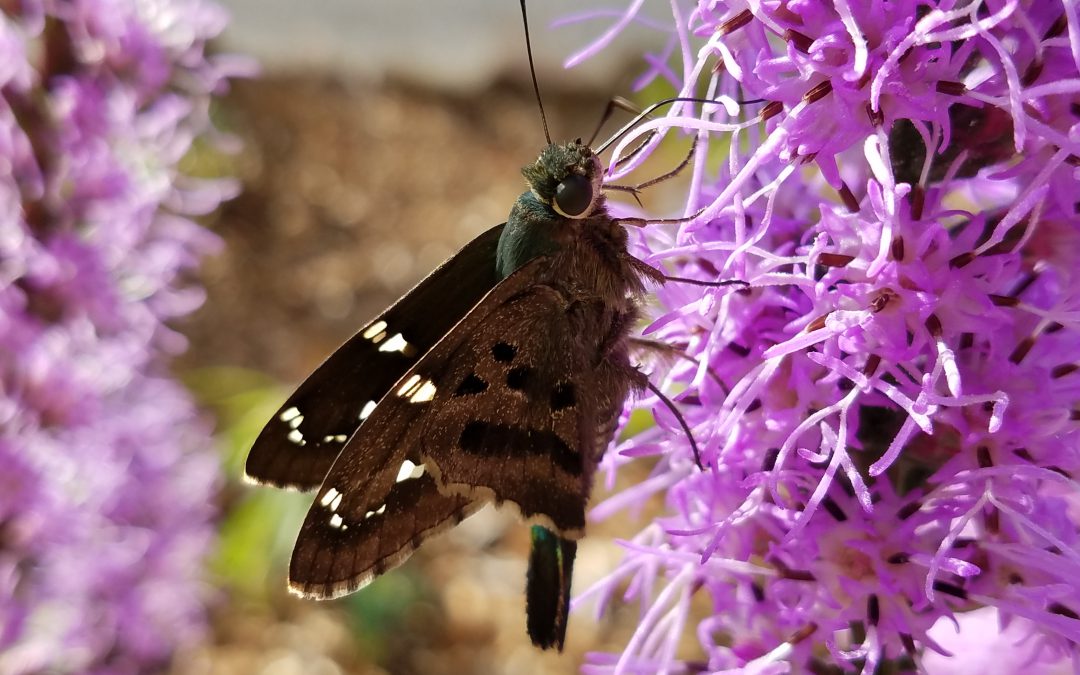
by Evan Anderson | Nov 18, 2020
We don’t always have to look closely or work hard to find beauty in our surroundings. While a well-tended landscape can certainly enhance the aesthetics of an area, there are plenty of places to find naturally attractive plants. With the benefit of being easy to care for, wildflowers are a great option for increasing the appeal of an area not just for people, but for wildlife and pollinators as well.
Not every wildflower is easy to grow or desirable in a landscape. Some have specific requirements that must be met for them to thrive, and some might be too vigorous in their growth. Invasive plants don’t make good neighbors. There are some, however, that have all the right characteristics to make them a solid choice in almost any landscape. Here are four of those that are beautiful, well adapted to the climate and soil in North Florida, and don’t necessarily make pests of themselves.
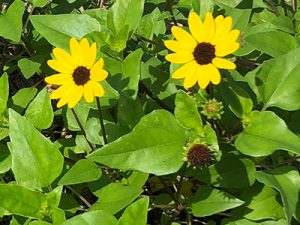
Beach Sunflower
Photo: Evan Anderson
Beach Sunflower
https://edis.ifas.ufl.edu/fp245
Helianthus debilis, also known as beach or dune sunflower, is a perennial in warmer areas, but may die back during the winter in North Florida. Different varieties may sprawl or stand upright, reaching anywhere from one to four feet in height. Blooms may be found on this plant year-round, and even in areas where it is impacted by freezes it will reseed itself.
Beach sunflower prefers a sunny location and are hardy enough to withstand some fairly marginal locations. With good salt and drought tolerance, this plant can be established in an area and left to its own devices. Too much water and fertilizer can be more of a problem for them than too little, though a little of each can help if faster growth is needed. Just be sure to give it enough room, as it likes to spread out, and be ready to trim back old growth every few months to keep plants looking good.
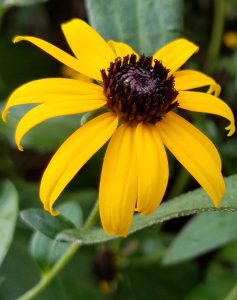
Black-eyed-susan.
Photo: Evan Anderson
Black-eyed Susan
https://edis.ifas.ufl.edu/fp512
Rudbeckia species are often known as Black- or Brown-eyed Susan. Native species and varieties can be found that are well adapted to life in Florida. With their distinctive bright yellow petals surrounding a black or brown center, Black-eyed Susans make great cut flowers and are an attractive addition to landscapes. Generally reaching one to two feet in height and spreading two to three feet, they bloom from spring to fall. Different varieties may be annual, perennial, or biennial.
Preferring full sun (though at least one variety tolerates part shade well) and well-drained soil, Rudbeckia does not mind drought or salt spray. Regular deadheading can help keep these plants looking their best.
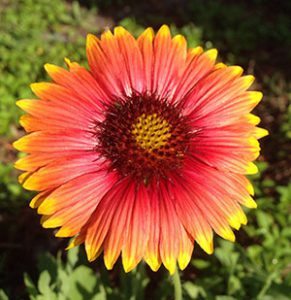
Blanketflower
Photo: Evan Anderson
Blanketflower
https://edis.ifas.ufl.edu/fp216
Gaillardia pulchella is a fiery-looking flower that provides pollinators with nectar and onlookers with a bright pop of color. Growing even in the meanest beach sand, blanketflower blooms from mid-spring to late summer, declining as weather cools. It relies upon its impressive ability to reseed itself to replenish itself each year and can spread rapidly in better soils. Those plants that do persist into cooler weather are in no need of protection, being able to withstand temperatures even into the 20s.
Relatively pest and disease free, plant this wildflower in full sun. It may tolerate some shade, but it will become leggy and creep in search of sun in such places. Dry or well-drained soil is best; certainly avoid over-watering.
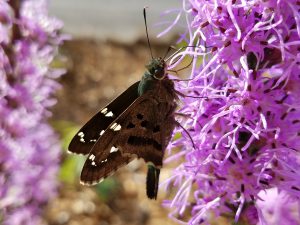
Blazing Star
https://gardeningsolutions.ifas.ufl.edu/plants/ornamentals/liatris.html
There are several species of Liatris native to Florida, any of which can be planted in the panhandle. Tall and showy, the purple blossoms open from the top of the 2-4 foot flower stalk and continue downward. They make great cut flowers and can be placed even in small gardens; while they are tall, they tend not to spread very far. Butterflies, bees, hummingbirds, and other pollinators are attracted to these plants, which tend to bloom in the fall.
Blazing star prefers to be planted in full sun, regardless of species. Well-drained soil is best, though one species, Dense blazing star, does well in moist or wet soils. These flowers do not tend to be firmly rooted, so take care when trimming back dead stems. Consider leaving the stalks alone for a while, even if they aren’t the prettiest things – they will reseed themselves and birds may enjoy making a snack of the seeds.
There are, of course, many more wildflowers out there. These are only a few of the options available. Not all wildflowers are suited to formal landscapes and may be better for informal or naturalized areas. For more information, visit the Florida Wildflower Foundation at https://flawildflowers.org/, the UF/IFAS Florida-Friendly Landscaping™ Program’s Butterfly Gardens mobile web app at https://ffl.ifas.ufl.edu/butterflies/, or the UF/IFAS EDIS publications https://edis.ifas.ufl.edu/topic_wildflowers.
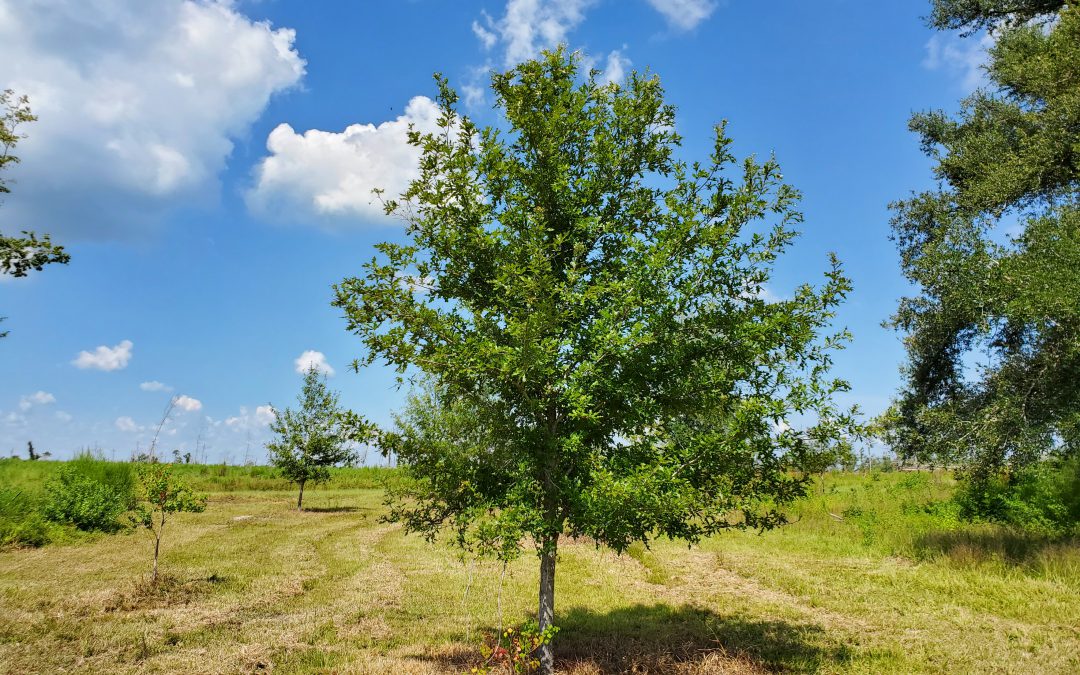
by Daniel J. Leonard | Sep 3, 2020
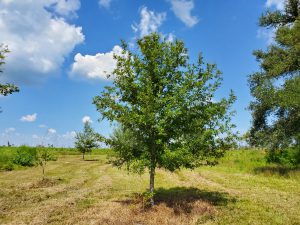
Overcup on the edge of a wet weather pond in Calhoun County. Photo courtesy of Daniel Leonard.
Haunting alluvial river bottoms and creek beds across the Deep South, is a highly unusual oak species, Overcup Oak (Quercus lyrata). Unlike nearly any other oak, and most sane people, Overcups occur deep in alluvial swamps and spend most of their lives with their feet wet. Though the species hides out along water’s edge in secluded swamps, it has nevertheless been discovered by the horticultural industry and is becoming one of the favorite species of landscape designers and nurserymen around the South. The reasons for Overcup’s rise are numerous, let’s dive into them.
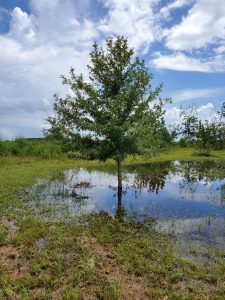
The same Overcup Oak thriving under inundation conditions 2 weeks after a heavy rain. Photo courtesy Daniel Leonard.
First, much of the deep South, especially in the Coastal Plain, is dominated by poorly drained flatwoods soils cut through by river systems and dotted with cypress and blackgum ponds. These conditions call for landscape plants that can handle hot, humid air, excess rainfall, and even periodic inundation (standing water). It stands to reason our best tree options for these areas, Sycamore, Bald Cypress, Red Maple, and others, occur naturally in swamps that mimic these conditions. Overcup Oak is one of these hardy species. It goes above and beyond being able to handle a squishy lawn, and is often found inundated for weeks at a time by more than 20’ of water during the spring floods our river systems experience. The species has even developed an interested adaptation to allow populations to thrive in flooded seasons. Their acorns, preferred food of many waterfowl, are almost totally covered by a buoyant acorn cap, allowing seeds to float downstream until they hit dry land, thus ensuring the species survives and spreads. While it will not survive perpetual inundation like Cypress and Blackgum, if you have a periodically damp area in your lawn where other species struggle, Overcup will shine.
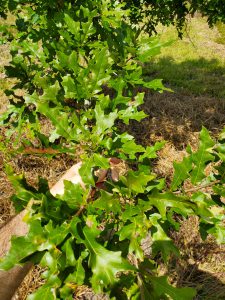
Overcup Oak leaves in August. Note the characteristic “lyre” shape. Photo courtesy Daniel Leonard.
Overcup Oak is also an exceedingly attractive tree. In youth, the species is extremely uniform, with a straight, stout trunk and rounded “lollipop” canopy. This regular habit is maintained into adulthood, where it becomes a stately tree with a distinctly upturned branching habit, lending itself well to mowers and other traffic underneath without having to worry about hitting low-hanging branches. The large, lustrous green leaves are lyre-shaped if you use your imagination (hence the name, Quercus lyrata) and turn a not-unattractive yellowish brown in fall. Overcups especially shine in the winter when the whitish gray shaggy bark takes center stage. The bark is very reminiscent of White Oak or Shagbark Hickory and is exceedingly pretty relative to other landscape trees that can be successfully grown here.
Finally, Overcup Oak is among the easiest to grow landscape trees. We have already discussed its ability to tolerate wet soils and our blazing heat and humidity, but Overcups can also tolerate periodic drought, partial shade, and nearly any soil pH. They are long-lived trees and have no known serious pest or disease problems. They transplant easily from standard nursery containers or dug from a field (if it’s a larger specimen), making establishment in the landscape an easy task. In the establishment phase, defined as the first year or two after transplanting, young transplanted Overcups require only a weekly rain or irrigation event of around 1” (wetter areas may not require any supplemental irrigation) and bi-annual applications of a general purpose fertilizer, 10-10-10 or similar. After that, they are generally on their own without any help!
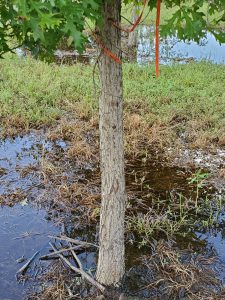
Typical shaggy bark on 7 year old Overcup Oak. Photo courtesy Daniel Leonard.
If you’ve been looking for an attractive, low-maintenance tree for a pond bank or just generally wet area in your lawn or property, Overcup Oak might be your answer. For more information on Overcup Oak, other landscape trees and native plants, give your local UF/IFAS County Extension office a call!
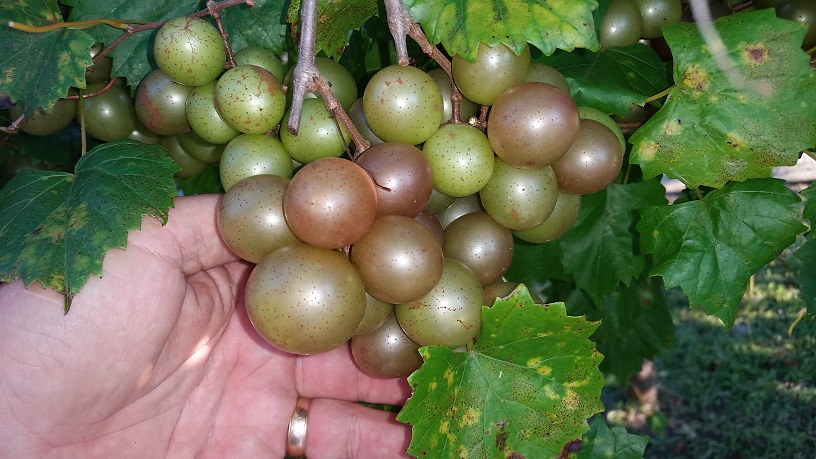
by Erik Lovestrand | Aug 27, 2020
When we moved to the Florida Panhandle in 1989 and bought a house in Wakulla County, my wife and I inherited a grape arbor that was planted by the original builder of the home many years previous. It consisted of three 4×4 posts with cross pieces at the top and a run of heavy gauge wire out near the ends of each cross piece. Maintenance had been lacking for some years so the vines had grown into a massive tangle which at first glance, I surmised I would end up cutting down to help improve the appearance of the property. Well, as is often the case, timing is everything and the existence to this day of that grape arbor, is due to the fact that it was late summer and the vines had some fruit on them. It only took one taste of a sweet, flavorful black muscadine grape to decide they were worth keeping. Little did I know what I was in for though, when it came to properly managing this “wildling” for a productive, beautiful arbor; one that now provides many culinary options, as well as a pleasing, eye-catching aspect in our home landscape.
After looking closer at the vines, it appeared that there were two different species of grapes growing. The very dark purple (almost black) muscadines, were dwarfed by much larger greenish-bronze grapes at one end of the arbor. I now know that these grapes are typically referred to as scuppernongs by most locals and they are actually the same species as the dark grapes. In fact, Vitus rotundifolia is the scientific name for our native wild grapes that have a range from Florida to New Jersey in the east, and west to Texas and Oklahoma. The fruits of this species can be bronze, black or red, depending on the cultivar and they are the same species I remembered picking from wild vines as a youth, which ranged in size from ¼ to ½ inch and were often quite tart. Currently, there are about 150 cultivars of muscadine grapes grown for their fruit and their innate resistance to pests and diseases.
The reason for the two varieties on our grape arbor had to do with the fact that many muscadines produce only pistillate flowers and require pollen from another variety to produce fruit. A few varieties have perfect flowers and can produce fruit on their own, notably Carlos and Noble. Writings about these native grapes date back to the early 1500’s as early explorers of the Cape Fear River Valley in modern-day North Carolina described its abundance and pleasing qualities. The common name “scuppernong” is derived from the Scuppernong River in North Carolina but the name has many variations depending on the locale (scuplin, scufalum, scupanon, scupadine, scuppernine, scupnun, and scufadine). The word “scuppernong” comes from the Algonquian “askuponong,” meaning “place of the askupo,” which is the sweet bay tree (Magnolia virginiana). Cultivation has been recorded as early as the 17th century and with over 100 years of breeding, several bronze cultivars such as Carlos, Doreen, Magnolia and Triumph, are distinguished by having perfect flowers. There is one particular vine on Roanoke Island North Carolina that is considered by many to be the “Mother Vine” for all modern day varieties. This vine has been cultivated for around 400 years, to-date.
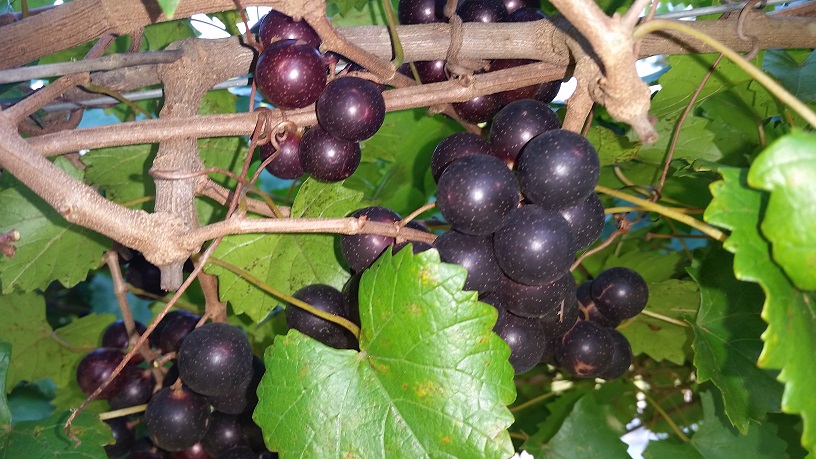
Dark purple muscadine grapes are often called “black grapes.”
If by this time, you are working up a craving for a taste of muscadines, you are not alone because late-summer is the peak production period for many vines around the region. If you do not have your own vines, you are still able to get these grapes at several places around our area. Visit this link for a list of wineries and vineyards in Florida, some of which run u-pick operations. Or you may even have a nearby neighbor with an abundance of fruit and generosity. Some cultivated varieties are suitable for table fare as they have fewer seeds and thinner skins. The tougher-skinned varieties are suitable for jellies, jams, grape butter, and wine making. Bronze scuppernongs produce a very light-colored wine with a mild fruity flavor, while the dark purple muscadines derive a dark reddish, and stronger flavored wine. No matter the type of muscadine, they all provide important habitat and food for many wild critters as well. Thankfully, they generally produce enough bounty to go around and I never begrudge the opossums, raccoons, squirrels and birds their share of the blessing.






















